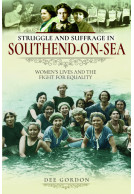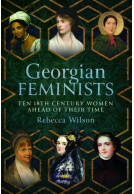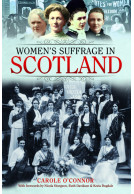Struggle and Suffrage in Morpeth & Northumberland (ePub)
Women's Lives and the Fight for Equality
Imprint: Pen & Sword History
Series: Struggle and Suffrage
File Size: 17.0 MB (.epub)
Pages: 112
ISBN: 9781526719676
Published: 19th October 2020
| Other formats available | Price |
|---|---|
| Struggle and Suffrage in Morpeth… Paperback Add to Basket | £12.99 |
For much of the nineteenth century, the women of Northumberland had occupied crucial, though largely underappreciated and acknowledged, roles within society. Aside from the hard life of raising families in an area where money was often hard to come by, and where much of the available work was labour intensive and dangerous, women were also expected to play a role in bringing money into the household.
In what was a largely agrarian county, female labourers, who were known as bondagers, were widely respected for their contribution to the local economy although there were those who criticised the system for forcing women to undertake hard manual labour. The farming economy in Northumberland depended so much upon female labour that many men found that it was far easier to be taken on by a prospective employer if they could assure that employer that they would be able to bring a suitable female worker with them.
The period was also one of considerable upheaval. There were a number of prominent Northumbrian suffragists and the local radical suffragettes launched a number of attacks in the area. Morpeth was a very early supporter of women’s suffrage and the Mayor and local council actively gave their support to the cause, although they remained largely opposed to the actions of the suffragettes. Although born in London, Emily Wilding Davison's mother was Northumbrian and she had a wide network of relations in Morpeth and throughout the county. After her father’s death her mother had relocated to the Northumberland village of Longhorsley and Emily spent long period with her, recuperating after her numerous hunger strikes. Famously losing her life after being struck by the King’s horse at the 1913 Derby, Emily was buried with great ceremony in a quiet Morpeth churchyard and to this day she remains one of Morpeth’s most famous (adopted) daughters, with her grave remaining a sight of pilgrimage for many supporters of women’s rights.
This book starts in Victorian Britain with information about the census and the type of working conditions the women had to endure. Centring on the harsh farming jobs and conditions they put up with. As Northumberland was sparsely populated it was the ideal farming area.
Doncaster & District Family History Society (Doncaster Ancestor)
It isn’t until we move into the Edwardian age that Suffrage & the Suffragettes movement is mentioned. What did surprise me was that quite a number of men gave their support and help to the movement. The book gives a good amount of detail about Emily Davison, the lady who later went on to throw herself in front of the Kings horse. (Taking things into her own hands, though now there seems to be some doubt as to what was supposed to happen). This lady seems to have been rather a maverick, taking matters into her own hands without the permission of the WSPU. The horse incident really seems to have been the turning point in 1913, and then of course came the First World War when it was estimated that 2 million women replaced men in employment & proved invaluable in the war effort.
This book also contains an index which can often prove useful for family historians.
As a big fan and supporter of promoting women’s history, this series of books combined in the format of my favourite ‘Your Towns and Cities’ series it’s quite obvious that I am going to enjoy it and recommend it to others. Just like the Your Towns and Cities it gives you a good history of local news and events that affect the area, combined with a small slice of national news of the time. An excellent combination and ideal for the person who wants to learn about local history and how that can coincide with national events. I really enjoyed this book indeed, and I also got to learn about how Emily Davison’s mother came from the area and we got a glimpse at how they saw the suffrage movement from their own rural opinion. Along with how Emily Davison is buried there in a quiet graveyard. My only criticism of the book was that it was a bit short and I would have liked to have read a longer book or it could have gone into more depth. Written by Craig Armstrong, having read a few of his I like his writing style which helped with the enjoyment of the book. Have a look at this book or certainly some of the others from this series.
UK Historian
⭐⭐⭐⭐⭐
Read the full review here
About Dr Craig Armstrong
Born and bred in Northumberland, Dr Craig Armstrong is an experienced historian,with a special interest in the history of the North East of England and Scotland. He works as a freelance author and has taught history at both Newcastle University and Northumbria University.


























